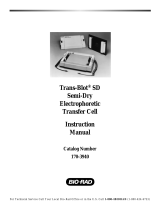Page is loading ...

INSTRUCTIONS
Pierce Biotechnology
PO Box 117
(815) 968-0747
www.thermoscientific.com/pierce
3747 N. Meridian Road
Rockford, lL 61105 USA
(815) 968-7316 fax
Number Description
22363
SMPH (Succinimidyl-6-[(β-maleimidopropionamido)hexanoate]), 50mg
Molecular Weight: 379.36
Spacer Arm Length: 14.2Å
Storage: Upon receipt store desiccated at 4°C.
Product is shipped at ambient temperature.
N
H
O
N
O
O
O
O
N
O
O
Introduction
Thermo Scientific SMPH is a heterobifunctional crosslinker with N-hydroxysuccinimide (NHS) ester and maleimide groups
that allow covalent conjugation of amine- and sulfhydryl-containing molecules. NHS esters react with primary amines at pH
7-9 to form amide bonds, while the maleimides react with sulfhydryl groups at pH 6.5-7.5 to form stable thioether bonds. In
aqueous solutions, hydrolytic degradation of the NHS ester is a competing reaction whose rate increases with pH. The
maleimide group is more stable than the NHS-ester group but will slowly hydrolyze and also lose its reaction specificity for
sulfhydryls at pH values greater than 7.5. For these reasons, conjugation experiments involving this type of
heterobifunctional crosslinker are usually performed at pH 7.2-7.5, with the NHS-ester (amine-targeted) reaction being
accomplished before or simultaneous with the maleimide (sulfhydryl-targeted) reaction.
SMPH can be used to prepare antibody-enzyme and hapten-carrier protein conjugates in a two-step reaction scheme. First,
the amine-containing protein is reacted with a several-fold molar excess of the cross-linker, followed by removal of excess
(nonreacted) reagent by desalting or dialysis; finally, the sulfhydryl-containing molecule is added to react with the maleimide
groups already attached to the first protein.
SMPH is not directly water-soluble and must be dissolved first in an organic solvent such as dimethylsulfoxide (DMSO) or
dimethylformamide (DMF). Subsequent dilution into aqueous reaction buffer is generally possible, and most protein
reactants will remain soluble if the final concentration of organic solvent is less than 10%.
Important Product Information
• SMPH crosslinker is moisture-sensitive. Store vial of reagent in desiccant at the specified temperature. Equilibrate vial to
room temperature before opening to avoid moisture condensation inside the container. Dissolve needed amount of
reagent and use it immediately before hydrolysis occurs. Discard any unused reconstituted reagent. Do not attempt to
make and store stock solutions.
• Avoid buffers containing primary amines (e.g., Tris or glycine) and sulfhydryls during conjugation because they will
compete with the intended reaction. If necessary, dialyze or desalt samples into an appropriate buffer such as phosphate
buffered saline (PBS).
• Molecules to be reacted with the maleimide moiety must have free (reduced) sulfhydryls. Reduce peptide disulfide bonds
with Thermo Scientific Immobilized TCEP Disulfide Reducing Gel (Product No. 77712). Reduce disulfide bonds in high
molecular weight proteins using 5mM TCEP (1:100 dilution of Thermo Scientific Bond-Breaker TCEP Solution,
Product No. 77720) for 30 minutes at room temperature, followed by two passes through an appropriate desalting
column (e.g., Thermo Scientific Zeba Spin Desalting Columns). Be aware that proteins (e.g., antibodies) may be
inactivated by complete reduction of disulfide bonds they contain. Selective reduction of hinge-region disulfide bonds in
IgG may be accomplished with 2-Mercaptoethylamine•HCl (2-MEA, Product No. 20408). Sulfhydryls may be added to
molecules using N-succinimidyl S-acetylthioacetate (SATA, Product No. 26102) or 2-iminothiolane•HCl (Traut’s
Reagent, Product No. 26101), which modify primary amines.
0771.2
22363
SMPH

Pierce Biotechnology
PO Box 117
(815) 968-0747
www.thermoscientific.com/pierce
3747 N. Meridian Road
Rockford, lL 61105 USA
(815) 968-7316 fax
2
Procedure for Two-step Protein Crosslinking
Generally, a 10- to 50-fold molar excess of crosslinker over the amount of amine-containing protein results in sufficient
maleimide activation to enable several sulfhydryl-containing proteins to be conjugated to each amine-containing protein.
More dilute protein solutions require greater fold molar excess of reagent to achieve the same level of activation. Empirical
testing is necessary to determine activation levels and final conjugation ratios that are optimal for the intended application.
A. Material Preparation
• Conjugation Buffer: Phosphate buffered saline (PBS, pH 7.2; e.g., Product No. 28372) or other amine- and sulfhydryl-
free buffer at pH 6.5-7.5 (see Important Product Information) – adding EDTA to 1-5mM helps to chelate divalent metals,
thereby preventing disulfide formation in the sulfhydryl-containing protein
• Desalting column to separate modified protein from excess cross-linker and reaction byproducts (e.g., Zeba™ Spin
Desalting Columns)
• Amine-containing protein (Protein-NH2) and sulfhydryl-containing protein (Protein-SH) to be conjugated
B. Protocol
Note: For best results, ensure that Protein-SH is prepared (see Important Product Information) and ready to combine with
Protein-NH2 in step 5.
1. Dissolve Protein-NH2 in Conjugation Buffer at 0.1mM (e.g., 5mg in 1mL for a 50kDa protein).
2. Add crosslinker to dissolved Protein-NH2 at 1mM final (= 10-fold molar excess) by dissolving 3.80mg SMPH in 1mL
DMSO (makes 10mM) and then adding 100µL/mL of Protein-NH2 solution.
3. Incubate reaction mixture for 30 minutes at room temperature or 2 hours at 4°C.
4. Remove excess crosslinker using a desalting column equilibrated with Conjugation Buffer.
Note: Follow the desalting column product instructions to determine which fractions contain Protein-NH2. Alternatively,
locate the protein by measuring for fractions having peak absorbance at 280nm; however, be aware that the NHS-ester
leaving group also absorbs strongly at 280nm.
5. Combine and mix Protein-SH and desalted Protein-NH2 in a molar ratio corresponding to that desired for the final
conjugate and consistent with the relative number of sulfhydryl and activated amines that exist on the two proteins.
6. Incubate the reaction mixture at room temperature for 30 minutes or 2 hours at 4°C.
Note: Generally, there is no harm in allowing the reaction to proceed for several hours or overnight, although usually the
reaction will be complete in the specified time. To stop the conjugation reaction before completion, add buffer
containing reduced cysteine at a concentration several times greater than the sulfhydryls of Protein-SH.
Note: Conjugation efficiency may be estimated by electrophoresis separation and subsequent protein staining.
Related Thermo Scientific Products
Table 1. Noncleavable NHS/Maleimide crosslinkers.
Crosslinker Name
Spacer Arm
Length (Å)
Spacer Arm Composition (between
ester and maleimide)
Product No.
(NHS)
Product No.
(Sulfo-NHS)
AMAS
4.4
Alkane
22295
NA
BMPS
5.9
Alkane
22298
NA
GMBS
7.3
Alkane
22309
22324
MBS
7.3
Aromatic
22311
22312
SMCC
8.3
Cyclohexane
22360
22322
EMCS
9.4
Alkane
22308
22307
SMPB
11.6
Alkane/Aromatic
22416
22317
SMPH
14.2
Alkane/Amide
22363
NA
LC-SMCC
16.2
Alkane/Amide/Cyclohexane
22362
NA
KMUS 16.3 Alkane NA 21111
Product Reference
Chen, Z., et al. (2003). Spatial and dynamic interactions between phospholamban and the canine cardiac Ca2+ pump revealed with use of heterobifunctional
crosslinking agents. J Biol Chem 278(48):48348-56.

Pierce Biotechnology
PO Box 117
(815) 968-0747
www.thermoscientific.com/pierce
3747 N. Meridian Road
Rockford, lL 61105 USA
(815) 968-7316 fax
3
This product (“Product”) is warranted to operate or perform substantially in conformance with published Product specifications in effect at the time of sale,
as set forth in the Product documentation, specifications and/or accompanying package inserts (“Documentation”) and to be free from defects in material and
workmanship. Unless otherwise expressly authorized in writing, Products are supplied for research use only. No claim of suitability for use in applications
regulated by FDA is made. The warranty provided herein is valid only when used by properly trained individuals. Unless otherwise stated in the
Documentation, this warranty is limited to one year from date of shipment when the Product is subjected to normal, proper and intended usage. This
warranty does not extend to anyone other than the original purchaser of the Product (“Buyer”).
No other warranties, express or implied, are granted, including without limitation, implied warranties of merchantability, fitness for any particular
purpose, or non infringement. Buyer’s exclusive remedy for non-conforming Products during the warranty period is limited to replacement of or
refund for the non-conforming Product(s).
There is no obligation to replace Products as the result of (i) accident, disaster or event of force majeure, (ii) misuse, fault or negligence of or by Buyer, (iii)
use of the Products in a manner for which they were not designed, or (iv) improper storage and handling of the Products.
Current product instructions are available at www.thermoscientific.com/pierce. For a faxed copy, call 800-874-3723 or contact your local distributor.
© 2012 Thermo Fisher Scientific Inc. All rights reserved. Unless otherwise indicated, all trademarks are property of Thermo Fisher Scientific Inc. and its
subsidiaries. Printed in the USA.
/














